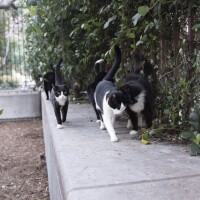House Cats: Why I Don't Let Mine Outside

There was something wrong with the cactus wren on our back porch. It was missing its tail feathers, for one thing. Cactus wrens fly into and out of some tricky places, and seeing a wren that's had a few feathers yanked out by some acacia thorn or cactus spine isn't all that unusual. But this one seemed subdued. And there was something odd about the way it held its head. I opened the sliding glass door to the porch: the mixed flock of sparrows and finches that had gathered around the sunflower seeds I put out each morning erupted into flight, but the wren just sat there.
I walked out onto the porch. It roused itself, skittered a few feet away from me, settled back down. I sat down too, on our "porch couch." If I'd been playing paramedic, I would have called the bird "shocky" -- every minute or so it closed its eyes, seemed with withdraw into itself, and then it would seem to shake itself awake. It seemed hungry. During its waking moments it would peck vainly at a sunflower seed, fail to open its shell, and then fade again.
On our kitchen counter was a half a slicing tomato left over from a previous meal. I put that outside and the wren, being a fruit-eating bird, went at it with some enthusiasm. Within half an hour or so it had decided I posed no threat, so I was able to get a good look at the right side of its face. It was missing an eye.
There are a number of ways a cactus wren could lose tail feathers. There are a few different ways one could lose an eye. Put both conditions together, though, and a single possibility looms large: the wren had been "catted."
There aren't a lot of outdoor cats in this neighborhood. You can tell because of the birds in our yard. We have our complement of quick and able fliers, the house finches and white-crowned sparrows, the scrub jays and mockingbirds and ladder-backed woodpeckers. But the most prominent demographic of our backyard's bird population prefer not to leave the ground. We have about 30 Gambel's quail that visit each day. We have at least two Crissal thrashers -- perhaps more. They're hard to tell apart. We've got a roadrunner that comes through each early afternoon.
And we've got the cactus wrens. They're strong fliers, but they're lazy. If they can walk somewhere, they will.
If there were a lot of cats in the neighborhood, our bird population would be very different. In San Francisco's Golden Gate Park, the native California quail have been nearly extirpated as a result of predation by feral cat colonies, as well as human interference with habitat. Ground-nesting birds like quail are extremely vulnerable to cats, as are birds like our thrashers that build nests only a few feet above the ground.
That's not to say that only ground-bound birds are vulnerable to cats. Estimates of mortality of birds of all kinds from cat predation run from the tens of millions to hundreds of millions per year in the U.S.
This is a big, emotional issue for a lot of people, as anything that involves kitties usually is. I've been an environmental activist for decades, and though I've written about off-road vehicle abuse in the desert and the environmental effects of U.S. immigration policy and the reactionary origins of the old-style Wise Use movement, the one story I wrote that got me the most actual threats of violence was one I wrote in 1999 that mentioned cat predation on birds, and the advisability of keeping one's pet cats indoors. One correspondent called me a vivisectionist, which would likely surprise the somewhat spoiled indoor cat currently interfering with my attempts to use my keyboard.
It didn't really matter that I prefaced that article with my love of cats. It didn't really matter that the science shows indoor cats live much longer than outdoor cats, due to protection from disease and fighting and speeding cars and dogs and -- in my neighborhood -- coyotes. I had suggested that cats might play a role in our species' destruction of wildlife and its habitat, and that made a few of those people angry enough to threaten me with physical harm.
Mainly, what such criticisms amount to is an allegation that observing the toll cats take on wildlife -- which includes native mammals, reptiles and amphibians, and invertebrates as well as birds -- is "blaming the cat." Some people upset about cat predation on wildlife do indeed blame the cats. I don't. When a cat preys on a small animal, it's doing what it is supposed to do. It's our introduction of cats to ecosystems where they're not suited that is "to blame."
That introduction can take place on a massive scale, as when cats were imported to New Zealand and let loose in wildlands to eat previously introduced rabbits, as a seriously distasteful result of which the New Zealand government now pays hunters to shoot cats in the wild. Or the introduction can take place on a small scale, every day, when you allow your cat to head outdoors.
I suspect that some of the reason for the heat involved in the issue is that people identify with cats. Most cat lovers look at a cat and see an individual not unlike themselves: a "person," someone with distinct likes and distastes, with idiosyncracies, with a life history that deserves respect. I'm one of those people.
I suspect that for most people, that identification doesn't fully extend to wild animals other than a few popular kinds: wolves, bears, big cats, the occasional charismatic bird of prey. I suspect that for smaller wildlife like packrats, side-blotched lizards, and cactus wrens, fewer people routinely think of them as individual conscious beings. But they are. They have awareness, though it may be different from our own. They have fears and they have contentment. They can suffer. If we prick them, they bleed. And a very large percentage of them end their lives in one form of agony or another.
This knowledge can make wildlife-watching difficult. It can ruin a day-long hike. And it can add a note of melancholy to a morning like today's, when I went out into the yard with coffee brewing, tossed a few hands full of sunflower seed around for the quail, filled the little water dish from the hose, and didn't see that injured cactus wren anywhere. Did it get picked off by another predator approaching from its blind side; a cat, a kestrel, the roadrunner on a return visit? Did it descend into shock for the last time, its stomach full of tomato? Did it regain some strength after eating and fly off to regrow its tailfeathers? I have no way of knowing. My knowledge that the wren is an individual allotted one life on this Earth thus brings with it sadness at the wren's likely tragic end.
But that knowledge also makes it easy to keep the screen door closed with my cat on the other side of it.





